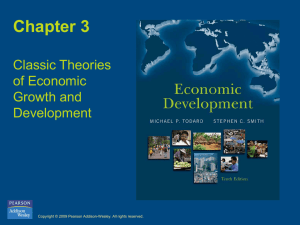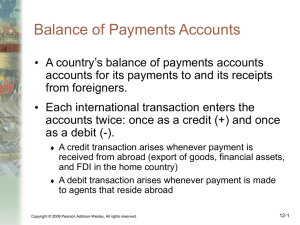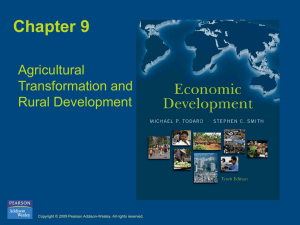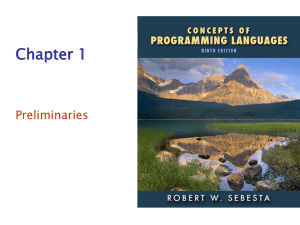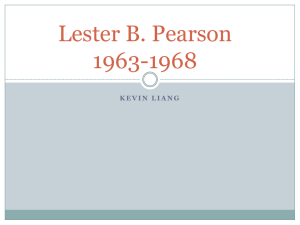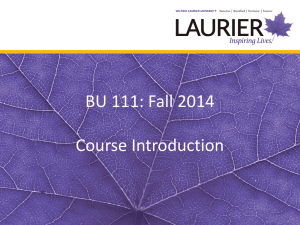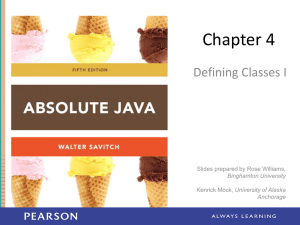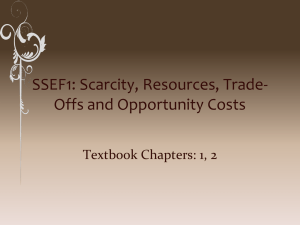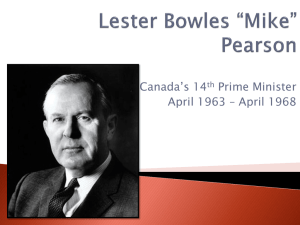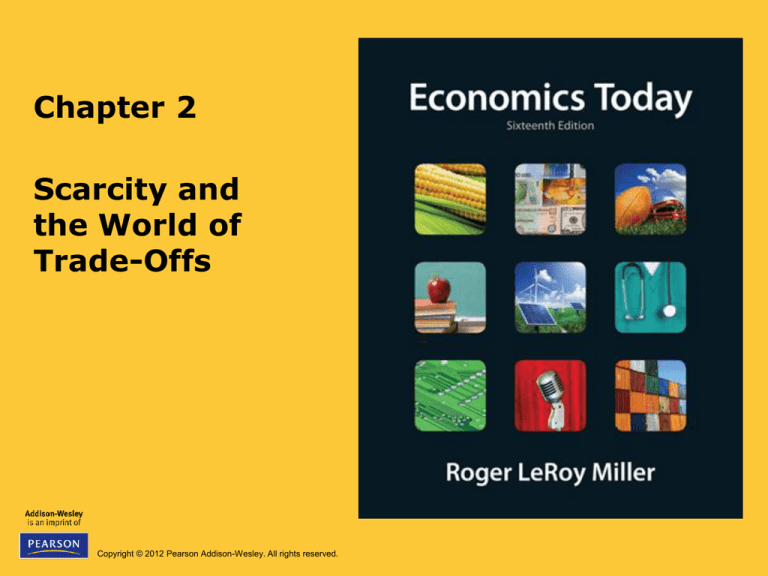
Chapter 2
Scarcity and
the World of
Trade-Offs
Copyright © 2012 Pearson Addison-Wesley. All rights reserved.
Introduction
Some economists suggest that adding an extra hour
during daylight saving time of the year actually
increases instead of saving energy expenses.
In this chapter, you will learn that making a choice to
obtain something, such as an extra hour of daylight,
involves an opportunity cost.
Copyright © 2012 Pearson Addison-Wesley. All rights reserved.
2-2
Learning Objectives
• Evaluate whether even affluent people face
the problem of scarcity
• Understand why economists consider
wants but not needs
• Explain why the scarcity problem induces
individuals to consider opportunity costs
Copyright © 2012 Pearson Addison-Wesley. All rights reserved.
2-3
Learning Objectives (cont'd)
• Discuss why obtaining increasing
increments of any particular good entails
giving up more and more units of other
goods
• Explain why society faces a trade-off
between consumption goods and capital
goods
• Distinguish between absolute and
comparative advantage
Copyright © 2012 Pearson Addison-Wesley. All rights reserved.
2-4
Chapter Outline
•
•
•
•
•
•
Scarcity
Wants and Needs
Scarcity, Choice, and Opportunity Cost
The World of Trade-Offs
The Choices Society Faces
Economic Growth and the Production
Possibilities Curve
Copyright © 2012 Pearson Addison-Wesley. All rights reserved.
2-5
Chapter Outline (cont'd)
• The Trade-Off Between the Present and
the Future
• Specialization and Greater Productivity
• Comparative Advantage and Trade Among
Nations
Copyright © 2012 Pearson Addison-Wesley. All rights reserved.
2-6
Did You Know That …
• A study by the Institute of Medicine has
found that reshuffling the schedules of
medical residents in order to give them
more rest breaks requires hospitals to hire
more residents to cover the scheduling
gaps?
• Time, like all other resources, is scarce.
Copyright © 2012 Pearson Addison-Wesley. All rights reserved.
2-7
Scarcity
• Scarcity
– Is the most basic concept in all of economics
– Occurs when the ingredients for producing
things that people desire are insufficient to
satisfy all wants
– Means we never have enough of everything,
including time, to satisfy our every desire
Copyright © 2012 Pearson Addison-Wesley. All rights reserved.
2-8
Scarcity (cont'd)
• What scarcity is NOT
– It is not a shortage
– It is not the same thing as poverty
Copyright © 2012 Pearson Addison-Wesley. All rights reserved.
2-9
Scarcity (cont'd)
• Production
– Any activity that results in the conversion of
resources into products that can be used in
consumption
• Resources or Factors of Production
– Inputs that are used to produce things that
people want
Copyright © 2012 Pearson Addison-Wesley. All rights reserved.
2-10
Scarcity (cont'd)
• Resources or Factors of Production
– Land
• Natural resources or the gifts of nature
– Labor
• The human resource
Copyright © 2012 Pearson Addison-Wesley. All rights reserved.
2-11
Scarcity (cont'd)
• Resources or Factors of Production
– Physical Capital
• All manufactured resources
– Human Capital
• Accumulated training and education of workers
Copyright © 2012 Pearson Addison-Wesley. All rights reserved.
2-12
Scarcity (cont'd)
• Resources or Factors of Production
– Entrepreneurship
• Person who organizes, manages, and assembles the
other resources
• Risk taker
• Maker of basic business policy decisions
Copyright © 2012 Pearson Addison-Wesley. All rights reserved.
2-13
Scarcity (cont'd)
• Goods versus Economic Goods
– Goods are all things from which individuals
derive satisfaction or happiness.
– Economic goods are scarce goods, for which
the quantity demanded exceeds the quantity
supplied at zero price.
Copyright © 2012 Pearson Addison-Wesley. All rights reserved.
2-14
Scarcity (cont'd)
• Services
– Tasks that are performed for someone else
– Can be referred to as intangible goods
Copyright © 2012 Pearson Addison-Wesley. All rights reserved.
2-15
Scarcity (cont'd)
• Recall
– Scarcity occurs when the ingredients
(resources) for producing things that people
desire are insufficient to satisfy all wants.
Copyright © 2012 Pearson Addison-Wesley. All rights reserved.
2-16
Wants and Needs
• Needs
– To economists, the term need is not definable.
• Wants
– Goods and services on which we place a
positive value
– People have unlimited wants.
Copyright © 2012 Pearson Addison-Wesley. All rights reserved.
2-17
Scarcity, Choice, and Opportunity
Cost
• Opportunity Cost
– The highest-valued, next-best alternative that
must be sacrificed to obtain something or to
satisfy a want
– The next-highest-ranked alternative, not all
alternatives
Copyright © 2012 Pearson Addison-Wesley. All rights reserved.
2-18
Scarcity, Choice,
and Opportunity Cost (cont'd)
• Questions
– What is the opportunity cost of attending this
economics class?
– What is the opportunity cost of attending a
concert by your favorite band?
– What is the opportunity cost of working out at
the gym?
Copyright © 2012 Pearson Addison-Wesley. All rights reserved.
2-19
Scarcity, Choice,
and Opportunity Cost (cont'd)
• In economics, cost is always a forgone
opportunity.
Copyright © 2012 Pearson Addison-Wesley. All rights reserved.
2-20
International Example: France is the Sleeping
Giant
• A study by the Organization of Economic
Cooperation and Development (OECD) indicates
that residents of France allocate about twice as
much time to eating as U.S. residents.
• The French also sleep more than people in other
countries, including the United States.
• So, French residents face a lower opportunity cost
of time devoted to eating and sleeping than U.S.
residents.
Copyright © 2012 Pearson Addison-Wesley. All rights reserved.
2-21
The World of Trade-Offs
• Whenever you engage in any activity,
using any resource, you are trading off the
use of that resource for one or more
alternative uses
• The value of the trade-off is represented
by the opportunity cost, (that which you
give up to obtain something else)
Copyright © 2012 Pearson Addison-Wesley. All rights reserved.
2-22
The World of Trade-Offs (cont'd)
• Graphical analysis of opportunity cost
– The production possibilities curve (PPC)
represents all possible combinations of
maximum outputs that could be produced
assuming a fixed amount of productive
resources of a given quality
Copyright © 2012 Pearson Addison-Wesley. All rights reserved.
2-23
Figure 2-1 Production Possibilities Curve for
Grades in Mathematics and Economics (Trade-Offs)
Copyright © 2012 Pearson Addison-Wesley. All rights reserved.
2-24
The World of Trade-Offs (cont'd)
• The Production Possibilities Curve (PPC)
– Trade-offs: What would happen if you are more
interested in getting a higher grade in
economics?
– Holding constant total study time: What would
happen to the PPC if you spent more time
studying?
– Straight-line PPC: Is it possible that the terms
of the trade-off might not be constant?
Copyright © 2012 Pearson Addison-Wesley. All rights reserved.
2-25
Example: Airlines Confront the Opportunity Cost
of Legroom on Planes
• Major U.S. airlines, such as American, Continental
and Delta, have added at least 10 more seats on
their planes by reducing 1 to 2 inches in the
distance between a point on one seat to the same
point on the seat in the next row.
• For these airlines, the thousands of dollars
generated by selling more ticketed passengers
onto each plane are an opportunity cost too high
to justify the extra passenger legroom.
Copyright © 2012 Pearson Addison-Wesley. All rights reserved.
2-26
The Choices Society Faces
• PPC is used to demonstrate related
concepts of scarcity, choice, and trade-offs
– At the individual level
– At the societal level
Copyright © 2012 Pearson Addison-Wesley. All rights reserved.
2-27
Figure 2-2 Society’s Trade-Off Between EReaders and Netbooks, Panel (a)
Copyright © 2012 Pearson Addison-Wesley. All rights reserved.
2-28
Figure 2-2 Society’s Trade-Off Between E-Readers
and Netbooks, Panel (b)
Copyright © 2012 Pearson Addison-Wesley. All rights reserved.
2-29
The Choices Society Faces (cont'd)
• Production possibilities assumptions
– Resources are fully employed
– Production takes place over a specific time
period
– Resources are fixed for the time period
– Technology does not change over the time
period
Copyright © 2012 Pearson Addison-Wesley. All rights reserved.
2-30
The Choices Society Faces (cont'd)
• Technology
– Society’s pool of applied knowledge concerning
how goods and services can be produced
Copyright © 2012 Pearson Addison-Wesley. All rights reserved.
2-31
Why Not … provide “free” health care to
everyone in the United States?
• Additional health care provided through
government programs is not really free.
• The new U.S. government health care program
has a 10-year price tag over $1 trillion indicates
that resources valued at this amount by society
would be allocated to producing more health care
instead of other items
Copyright © 2012 Pearson Addison-Wesley. All rights reserved.
2-32
The Choices Society Faces (cont'd)
• Efficiency
– Productive efficiency is producing the
maximum output with given technology and
resources
– Alternatively, the situation in which a given
output is produced at minimum cost
Copyright © 2012 Pearson Addison-Wesley. All rights reserved.
2-33
The Choices Society Faces (cont'd)
• Inefficient Point
– Any point below the production possibilities
curve at which the use of resources is not
generating the maximum possible output
• Law of Increasing Additional Cost
– As society attempts to produce more of a good,
the opportunity cost of additional units of that
good generally increases
– Accounts for bowed shape of the PPC
Copyright © 2012 Pearson Addison-Wesley. All rights reserved.
2-34
Figure 2-3 The Law of Increasing
Additional Cost
Copyright © 2012 Pearson Addison-Wesley. All rights reserved.
2-35
The Choices Society Faces (cont'd)
• Resources are not perfectly adaptable for
alternative uses
• In general, the more specialized the
resources, the more bowed the production
possibilities curve
Copyright © 2012 Pearson Addison-Wesley. All rights reserved.
2-36
Economic Growth and the
Production Possibilities Curve
• Economic growth
– Increases the production possibilities of ereaders and netbooks
– Over time, it is possible to have more of
everything
– Illustrated by an outward shift of the
production possibilities curve
Copyright © 2012 Pearson Addison-Wesley. All rights reserved.
2-37
Figure 2-4 Economic Growth Allows for
More of Everything
Copyright © 2012 Pearson Addison-Wesley. All rights reserved.
2-38
The Trade-Off Between
the Present and the Future
• The PPC can be used to illustrate the
trade-off between present and future
consumption
• Consumption
– The use of goods and services for personal
satisfaction
Copyright © 2012 Pearson Addison-Wesley. All rights reserved.
2-39
Figure 2-5 Capital Goods and Growth
• Consumer goods
– Goods produced for
personal satisfaction
• Capital goods
– Goods used to produce
other goods
Copyright © 2012 Pearson Addison-Wesley. All rights reserved.
2-40
Figure 2-5 Capital Goods and Growth,
Panel (a)
Copyright © 2012 Pearson Addison-Wesley. All rights reserved.
2-41
Figure 2-5 Capital Goods and Growth,
Panel (b)
Copyright © 2012 Pearson Addison-Wesley. All rights reserved.
2-42
The Trade-Off Between the Present and
the Future (cont’d)
• Capital Goods and Growth: Observations
– Forgo consumption goods to produce capital
goods
– Increase in capital goods stimulates economic
growth
Copyright © 2012 Pearson Addison-Wesley. All rights reserved.
2-43
The Trade-Off Between the Present and
the Future (cont’d)
• Observations
– An increase in capital goods at present will lead
to a higher rate of economic growth in the
future
– In the future, the economic system can
produce more consumer goods
Copyright © 2012 Pearson Addison-Wesley. All rights reserved.
2-44
Specialization and
Greater Productivity
• Specialization
– Organization of economic activity among
different individuals and regions
– Leads to greater productivity
Copyright © 2012 Pearson Addison-Wesley. All rights reserved.
2-45
Specialization and
Greater Productivity (cont'd)
• Comparative Advantage
– The ability to produce a good or service at a
lower opportunity cost
– Is always a relative concept
Copyright © 2012 Pearson Addison-Wesley. All rights reserved.
2-46
Specialization and
Greater Productivity (cont'd)
• Absolute Advantage
– The ability to produce more units of a good or
service using a given quantity of labor or
resource inputs
– Equivalently, the ability to produce the same
quantity of a good or service using fewer units
of labor or resource inputs
Copyright © 2012 Pearson Addison-Wesley. All rights reserved.
2-47
Specialization and
Greater Productivity (cont'd)
• Rational individuals choose their
comparative advantage and then specialize
• Specialization leads to division of labor
• Adam Smith, in The Wealth of Nations,
illustrated division of labor in pin making
Copyright © 2012 Pearson Addison-Wesley. All rights reserved.
2-48
Specialization and
Greater Productivity (cont'd)
• Division of Labor
– The segregation of resources into different
specific tasks
– For example, in automobile production, one
worker puts on bumpers, another work puts on
doors, and so on
Copyright © 2012 Pearson Addison-Wesley. All rights reserved.
2-49
Comparative Advantage
and Trade Among Nations
• Analysis of absolute advantage,
comparative advantage, and specialization
is applicable to individuals, groups of
people, or nations
• As a result, interstate trade occurs in the
United States and international trade
occurs between nations
Copyright © 2012 Pearson Addison-Wesley. All rights reserved.
2-50
Comparative Advantage
and Trade Among Nations (cont’d)
• When nations specialize where they have a
comparative advantage and then trade
with the rest of the world
– Economic efficiency improves
• Output increases
• Average standard of living rises
Copyright © 2012 Pearson Addison-Wesley. All rights reserved.
2-51
International Example: Time As a
Determinant of Comparative Advantage
• Technological improvements in production,
shipping, and delivery have enabled firms to use
“just-in-time inventory management” to move
newly produced items quickly to consumers.
• Nations where firms have implemented just-intime inventory management are more likely to
develop a comparative advantage over nations
where firms have not.
Copyright © 2012 Pearson Addison-Wesley. All rights reserved.
2-52
You Are There … Stopping Students’
Thursday Night Parties with Friday Classes
• A study suggests that students who consume
alcoholic beverages on Thursday nights would
choose not to do so if they had Friday classes to
attend.
• So, the provost of the University of Iowa decided
to raise students’ opportunity cost of attending
parties on Thursday nights by offering academic
departments an extra $20 for each student
rescheduled into a course that included a Friday
class.
Copyright © 2012 Pearson Addison-Wesley. All rights reserved.
2-53
Issues & Applications: Is Daylight Saving Time
Efficient?
• In the 1970s, the U.S. Department of
Transportation determined that, compared with
standard time, daylight saving time trimmed
national electricity usage by about 1 percent.
• A more recent study, however, found that greater
use of air conditioners to maintain lower
temperatures during longer summer evenings led
to greater use of electricity during daylight saving
time.
Copyright © 2012 Pearson Addison-Wesley. All rights reserved.
2-54
Summary Discussion
of Learning Objectives
• The problem of scarcity, even for the
affluent
– Scarcity and poverty are not synonymous
• Why economists consider individuals’
wants but not their needs
– Needs are not objectively definable
– Wants are things on which we place a positive
value
Copyright © 2012 Pearson Addison-Wesley. All rights reserved.
2-55
Summary Discussion
of Learning Objectives (cont'd)
• Why the scarcity problem leads people to
evaluate opportunity costs
– Allocating resources to producing one good
means losing the opportunity to have another
one
• Why getting more units of one good
requires giving up more and more of
another
– Resources are specialized
Copyright © 2012 Pearson Addison-Wesley. All rights reserved.
2-56
Summary Discussion
of Learning Objectives (cont'd)
• There is a trade-off between consumption
goods and capital goods.
– As more resources are devoted to the
production of capital goods, we can expect the
rate of economic growth to increase
Copyright © 2012 Pearson Addison-Wesley. All rights reserved.
2-57
Summary Discussion
of Learning Objectives (cont'd)
• Absolute versus comparative advantage
– One finds one’s absolute advantage by
producing more of a specific good than
someone else who uses the same amount of
resources
– One finds one’s comparative advantage by
looking at the activity that has the lowest
opportunity cost
Copyright © 2012 Pearson Addison-Wesley. All rights reserved.
2-58



